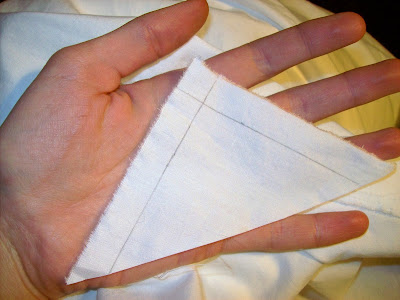Tape Weaving
I actually have been quite busy sewing and otherwise being crafty, but I haven't been disciplined about documenting my projects. In June, I made my first project on my tape loom: some linen tape for apron strings for a friend. It was based on the tape on an apron in the Schwenkfelder Library and Heritage Center: http://schwenkfelder.pastperfect-online.com/33016cgi/mweb.exe?request=record;id=83534E81-6AF2-4CAE-ADE0-332276277360;type=101. The original is red, blue, and white, but I made my copy using only blue and white as my friend wanted those colors to go with her blue and white checked apron. It took me a while to cut the threads and set up the loom, but weaving goes super fast. Do you know how fast? Warp speed! :D Where's my dilithium crystals? I think it only took me an hour to weave this piece.
 |
| This is the image in the Schwenkfelder museum (see hyperlink above). |
 |
| Here is my copy, though it's not as neat :( |
 |
| Weaving my first tape on my beautiful handmade loom from http://www.matthewstein.com/ |
 |
| Here's the finished tape, 106" long and 1/2" wide. |
This month, I've been weaving again to practice and experiment. I have a lot of room for improvement, and I'm kind of embarrassed to show this project that I just finished as it's a little sloppy, but I'd like to record what I've been learning. I just finished making a pair of garters based on some tape in the Schwenkfelder Library and Heritage Center (http://www.schwenkfelder.com/). You can search their collections catalog for "handwoven tape" to see images. Here's the tape that I tried to copy:
http://schwenkfelder.pastperfect-online.com/33016cgi/mweb.exe?request=record;id=EE97714B-B9C4-4AFA-A148-690958351533;type=101, though the image quality is poor. I wasn't able to get my tape to look quite the same, but it's close. It's brown, white, and orange, which intrigued me because most tape seems to be just blue and white, occasionally with some red. Many of the Schwenkfelder tapes are made from both linen and cotton, but I wanted to avoid cotton as linen was more common in 18th century America because flax was processed here before cotton became an American industry (source: Genesee Country Village and Museum, historical interpreter processing flax). There are no dates on the Schwenkfelder tapes; they could be from the early 18th century or perhaps 19th century.
 |
| I rolled paper onto the warp roller thing (is there a name for it?) to keep the threads from tangling in the nails. |
 |
| It's important to pull the threads taught to help keep even tension. |
I looked at all the images of tape that Schwenkfelder has and drew patterns for them on graph paper. I think I will adjust the patterns, though, because I want to achieve symmetrical colors. The opposing warp threads aren't directly on top of each other, they are side by side, and thus with each switching of the shed, the threads are essentially diagonal to each other. It's hard to describe, but if you weave, you probably understand. Anyway, I drew my diagrams to show that diagonal relationship instead of the traditional style with the colors shown directly above and below one another. It makes more sense to me to show how they are spaced horizontally as well. Now, next time I make something, I'd like to draw the threads with reflectional symmetry, which I can achieve by using an odd number of threads and having one central thread in the middle hole of the rigid heddle. For now, I have to be satisfied with translational symmetry. It bothers me, but I'm a little too picky about my projects and I have to just appreciate it for what it is. (Don't tell me geometry is useless, kids!!!)
 |
| My diagram showing translational symmetry of the warp threads. |
 |
| In progress. |
 |
| Close up of the finished tape; you can see the tension changing. |
The Challenge: pattern
Material: linen and wool thread
Pattern: my own, based on an original
Year: 18th-19th century (the museum didn't give a date)
Notions: sewing thread to fold and whip stitch the ends
How historically accurate is it? Pretty good, but I don't know. Maybe 80%
Hours to complete: Only an hour or so to weave, but another hour to cut threads and string the loom.
First worn: Not yet
Total cost: I don't remember how much the linen thread costs, but I've only used a little. The wool was a thrift store find. I estimate a few dollars U.S.






Comments
Post a Comment